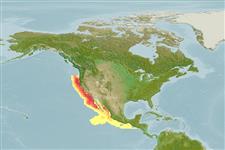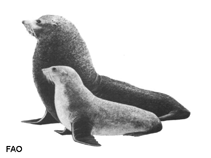Arctocephalus townsendi Merriam, 1897
Guadalupe fur seal| Native range | All suitable habitat | Point map | Year 2050 |

|
| This map was computer-generated and has not yet been reviewed. |
| Arctocephalus townsendi AquaMaps Data sources: GBIF OBIS |
Classification / Names Common names | Synonyms | CoL | ITIS | WoRMS
| Carnivora | Otariidae
Environment: milieu / climate zone / depth range / distribution range Sinh thái học
Tầng đáy biển sâu. Subtropical; 45°N - 13°N, 140°W - 180°E
Sự phân bố Các nước | Các khu vực của FAO | Các hệ sinh thái | Những lần xuất hiện | Những chỉ dẫn
Eastern Central Pacific: USA and Mexico.
Length at first maturity / Bộ gần gũi / Khối lượng (Trọng lượng) / Age
Maturity: Lm ? range ? - ? cm Max length : 190 cm TL con đực/không giới tính; (Ref. 1394); 140 cm TL (female); Khối lượng cực đại được công bố: 170.0 kg (Ref. 1394); Khối lượng cực đại được công bố: 170.0 kg
Short description Hình thái học
Dusky black with lighter ventrum. Gray head and shoulders, black nose with brown-red hair around the eyes. Guard hairs are white-tipped in adult males. Claws present in 5 fingers and absent on the 1st and 5th toes. Cartilaginous webbing extends past the claws. Females have 2 pairs abdominal nipples.
Found at sea, on beaches; when ashore, they prefer volcanic caves and grottos, or other rocky habitats. Found at sea, on beaches; when ashore, they prefer volcanic caves and grottos, or other rocky habitats. Both male and female territorial. Extralimital sightings in California corresponds with El Niño events (Ref. 1394).
Life cycle and mating behavior Chín muồi sinh dục | Sự tái sinh sản | Đẻ trứng | Các trứng | Sự sinh sản | Ấu trùng
Breeds near or in caves marked by the male as his territory. Mating occurs postpartum. Pups nurse for 9 to 11 months during which nursing females fast for an average of 5 days.
Main reference
Các tài liệu tham khảo | Người điều phối | Người cộng tác
Jefferson, T.A., S. Leatherwood and M.A. Webber. 1993. (Ref. 1394)
IUCN Red List Status (Ref. 130435)
Least Concern (LC) ; Date assessed: 10 October 2014
CITES status (Ref. 108899)
Appendix I: International trade banned
CMS (Ref. 116361)
Not Evaluated
Threat to humans
Human uses
Các nghề cá: Tính thương mại
FAO - Các nghề cá: species profile | FishSource | Biển chung quanh ta
Các công cụ
Thêm thông tin
Các nước
Các khu vực của FAO
Các hệ sinh thái
Những lần xuất hiện
Những chỉ dẫn
Stocks
Sinh thái học
Thức ăn
Các loại thức ăn
Các khu vực của FAO
Các hệ sinh thái
Những lần xuất hiện
Những chỉ dẫn
Stocks
Sinh thái học
Thức ăn
Các loại thức ăn
Tên thường gặp
Các synonym ( Các tên trùng)
Các động vật ăn mồi
Sự tái sinh sản
Chín muồi sinh dục
Đẻ trứng
Sự sinh sản
Các trứng
Egg development
Các synonym ( Các tên trùng)
Các động vật ăn mồi
Sự tái sinh sản
Chín muồi sinh dục
Đẻ trứng
Sự sinh sản
Các trứng
Egg development
Các nguồn internet
BHL | BOLD Systems | CISTI | DiscoverLife | FAO(Các nghề cá: species profile; publication : search) | Fishipedia | GenBank (genome, nucleotide) | GloBI | Gomexsi | Google Books | Google Scholar | Google | PubMed | Cây Đời sống | Wikipedia (Go, tìm) | Tạp chí Zoological Record
Estimates based on models
Preferred temperature
(Ref. 115969): 2.1 - 4, mean 3.1 (based on 48 cells).
Price category
(Ref. 80766):
Unknown.



